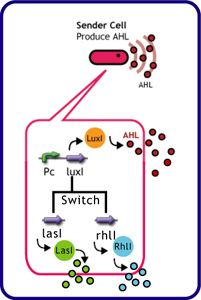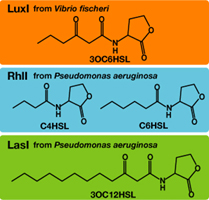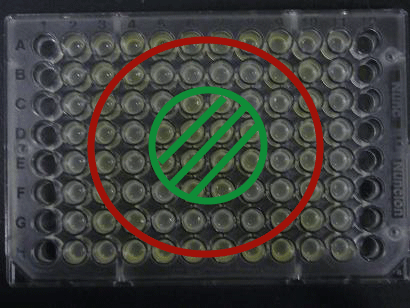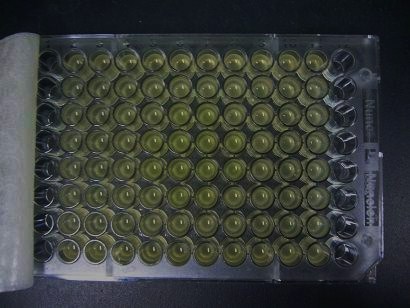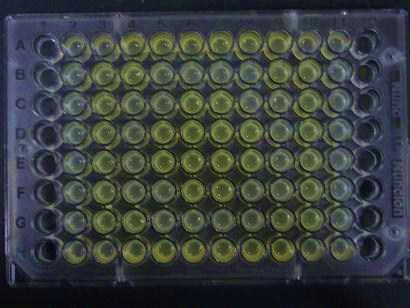Team:Chiba/Project/Experiments:Sender Crosstalk
From 2008.igem.org
| Home | The Team | The Project | Parts Submitted to the Registry | Reference | Notebook | Acknowledgements |
|---|
Sender Crosstalk
Design
Each species has their own LuxI-type proteins,which synthesize their specific autoinducers,AHLs.AHLs produced by different LuxI-type proteins differ only in the length of the acyl-chain moiety and substitution at position C-3.LuxR,which is original for Vibrio fischeri,is activated by its cognate autoinducer,3OC6HSL.However,LuxR is also activated by non-endogenous molecules,C4HSL,C6HSL,and 3OC12HSL.Activation by non-endogenous molecules requires a higher signal concentration(2).This results in slower activation of receivers,when AHL concentration is increasing.
異なる生物はそれぞれに異なるLuxIタイプのタンパク質を持ち、アシル鎖の長さ、あるいはC-3位の置換基が異なる種類のAHLを合成する。それぞれの生物種のLuxIタイプのタンパク質、それが合成する分子名は以下の表のようである。 (Fig.4).AHLを受け取り応答するLuxRタンパク質はVibrio fischeri由来であり、3OC6HSLに応答する。しかし、他種生物由来のAHLにも応答することが知られており、このとき、より高い濃度のAHLが必要となる(1),(2).AHLがゆっくり溜まっていく時、LuxRは3OC6HSLに対して最も早く応答し、他のAHLに対してはそれよりも遅く応答する。 (冨永)
Experiments
The purpose of this experiment was to create delays in communication time using cross-talk between non-specific signals. We used the following genes for this experiment.
| senders (cell: XL10-Gold or JW1908) | receiver (cell: JW1908) |
| *plac+rbs+LasI (pSB1AK3) | *BBa_T9002 (Express GFP in response to AHL) (pSB1A3) |
| *plac+rbs+RhlI (pSB1AK3) | |
| *BBa_K084009 | |
| *plac+rbs+LuxI (pSB1AK3) | |
| *BBa_K084014 | |
| *BBa_S03623(ptet+rbs+LuxI(LVA)) |
Details
Method
To characterize quorum sensing crosstalk, constitutive AHL senders were mixed with constitutive receivers and measure fluorescence intensity.
- Transformed Senders into E.coli strains(XL10Gold) and Receiver into E.coli strain(JW1908).
- Inoculated them independently in liquid media. Incubated at 37°C for 12hours.
- Mixed them.
- Incubated at 30°C.
- Measured intensity of green fluorescence(485 nm(excitation) and 527 nm(emission)) at regular time intervals.
Results & Discussion
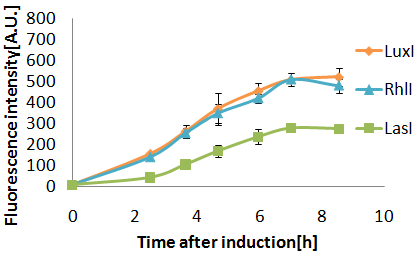
Senders(XL10Gold), T9002(JW1908)@30°C, Sender(μL):Receiver(μL)=500:500, 100:1000, 10:1000
- 37°Cで行った実験と比べ、LasIが活性。(8h後の蛍光強度、37°C:30°C=163:245)
- LasとLux(Plac)1:1で蛍光強度200に達するまでの時間に2.5時間の時差がみられた。
- Rhlのタグなしとタグ付きの差は、8h後の最終強度にしか現れなかった。
- また、差が一番でたのが30°Cで行ったこの実験で、タグなし:タグつき=507:456。
3OC6HSL,3OC12HSLに対する、LuxRの応答時間に、二時間の差ができた(3OC12HSLの場合、3OC6HSLに比べて二時間遅れて応答する)。 (そのときの条件は、培養温度30°C、genelatorの株はXL10Gold,Receiverの株はJW1908のとき、であった。) <??
Future plans
- AHL合成酵素の発現量を減らし,AHL生産速度を遅くする.
- RBSをweakにする。
- コピーナンバーをlowにする.
- transfer curveをシグモイダルに近づける.
- Positive Feedback Loopを導入する.
Other Experiments
Visual Judgement
- Fluorescence intensity was from 150 to 200 when the 2 mL of reaction culture in a test tube.
試験管内の培養液(2mL)が、緑色を呈しているときの蛍光強度:150~200。
Senders(JW1908),T9002(JW1908)@37°C,Sender(μL):Receiver(μL)=500:500,100:1000,10:1000
- CinI+LVAとLuxRのクロストークはどの菌数比でもおこらない。
- RhlIが(RhlI+LVA、LasI、CinI+LVAの中で)一番クロストークする。
- Sender同士のクロストークの時差(蛍光強度200に達するまでの時間)は、1時間以下の範囲でしか発生しなかった。
Senders(JW1908),T9002(JW1908)@30°C,Sender(μL):Receiver(μL)=500:500,100:1000,10:1000
- 特に37°Cで行ったときと差はない
- BWはクオラムセンシングをしやすい株なので、Senderを変えてもたいした時差が見られなかった。
- 次回からはSender側の株をXL10Gに代えて実験を行う。
Senders(XL10Gold),T9002(JW1908)@37°C, Sender(μL):Receiver(μL)=500:500,100:1000,10:1000
- SenderをBW株にして行った実験よりも、8時間後の蛍光強度が平均で200くらい落ちた。
- この条件ではLasIのクロストークは起こりにくい。
- (8h後の最終蛍光強度(菌比1:1)、LasI:LuxI(Ptet):RhlI:RhlI+LVA=163:267:394:325)
Senders(XL10Gold),T9002(JW1908)@25°C菌数(μL)、Sender:Receiver=500:500,100:1000,10:1000
- どのSenderもGFP強度20~50の範囲。ネガコン(T9002のみ)の値、40前後と変わらず。
(ただし、静置培養のため、しんとう培養した30°Cや37°Cとは条件が違う。)
Demo ~Senders~
I experimentally tested the sender genes LuxI and LasI which produce the greatest time difference. We mixed bacteria(XL10G) transformed with either the LuxI or LasI genes and bacteria (of the BW strain) transformed with the LuxR gene at a 1:1 ratio and visually observed GFP fluorescence.
Results
Green region: sender=LuxI (50 uL), Red circular region: sender=Las I (50 uL).
Receiver=LuxR (50 uL)
-->more about Demo experiments detail
references
- M.K Winson et al.:Construction and analysis of luxCDABE-based plasmid sensors for investigating N-acyl homoserine lactone-mediated quorum sensing.FEMS Microbiology Letters 163 (1998) 185-192
- BBa_F2620:Specificity
- Paul Williams.:Quorum sensing, communication and cross-kingdom signalling in the bacterial world.Microbiology 153 (2007), 3923-3938
 "
"

